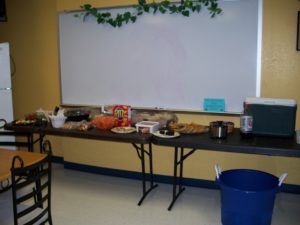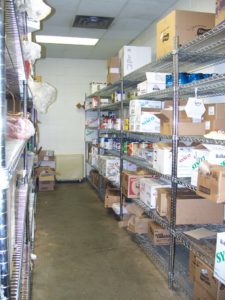As we come to the end of December and before you leave for the holidays please remember these tips so when you return you won’t be returning to unexpected guests.

This buffet of food left out overnight, or worse over a weekend or extended break can lead to pest infestation no one wants to face.
Tis the season for parties with cookies, pizza, gingerbread houses, drinks, and lots of sweet stuff. All of this left out when you go on break means when you get back you can enter your classroom or work space to find ants, cockroaches, mice and even rats. Don’t assume that custodial will make it to your area, be a good steward and clean it up, seal it up and make sure that when you get back you don’t have any unexpected visitors.
Storage of holiday decorations, school supplies, and other miscellaneous items usually ends up in cardboard boxes. Cardboard is great for temporary packaging, but not long term. Cardboard can harbor roaches, silverfish, mice, and mold.
It’s a fact that we may not want to hear, but clutter does not inspire, it creates chaos! And of course, nice nesting habitat for mice, roaches, silverfish, and ants which often follow. No true clutter connoisseur lives or works alone.
A cluttered workspace, be it a classroom or kitchen, creates barriers to efficiency and many (including students) may feel stressed with the informational and visual overload of a cluttered environment. Clutter also contributes to the accumulation of dust and provides harborage for insects such as cockroaches. In this way, clutter is more than a stress inducer; it can be a health concern.
De-cluttering has the immediate effect of eliminating pest harborage. When clutter is reduced, there is increased access to floor spaces, allowing for more thorough cleaning by custodial staff. The same is true for shelves and inside cupboards. Where there are nooks and crannies – created by “stuff” – pests will hide and breed among the clutter, there will be allergens and lots of bugs.
Clutter control also helps improve overall school hygiene. It’s easier for custodial staff to sweep, mop, and dust when things are generally organized. Minimizing clutter also helps teachers stay organized. It’s much easier to keep your room tidy when your cupboards and bookshelves are not overflowing with stuff!
Here are some tips to keep the clutter down and your area ready for your to work and learn.

This storage room has the potential to harbor roaches, ants, mice and other insect pests that most food service workers don’t want to see. Empty the boxes out or use durable plastic storage containers to store items like holiday decorations.
Kitchen staff
- Do not use corrugated cardboard for long term storage. German cockroaches are brought inside our schools hiding in the corrugations. They feed on the glue starch that holds the boxes together. Rotate out all corrugated cardboard if possible.
- Keep pantry shelving free of needless debris. Emptied supply boxes should be broken down and recycled rapidly.
- Clutter is also a problem around and in drains: debris blocking and clogging up drains can not only lead to maintenance issues, but drain flies love to breed in the scum that accumulates around the edges (and bleach won’t help!). Make sure all drains have covers, especially sink drains. There are heavy duty metal sink-drain baskets that can be dish washed.
Custodians

Leaving mops in the buckets can help cockroaches thrive, it also doesn’t help with mold and mildew. The mops should be hung just like the broom.
Though you are the sanitarians of your schools, in general you are not responsible for de-cluttering areas other than your own. Custodians can set a great president by maintaining well organized custodial closets.
- Hang brooms and mops (head end up) on a wall rack; brooms & mops are pest havens as they contain food, moisture, and a protected area in which to feed & breed. Keep these items hung up.
- Get good shelving! Too often, custodians have no shelving or organizational features in their closets. However, this is a “pest vulnerable area” and without organization it can lead to a rapid decline toward bugs, dirt and filth. Shelves should be wire (not wood), with the bottom shelf a minimum of 6” off the ground to allow for cleaning under. Use the IPM program you are part of as leverage for good quality shelving that will get your school on the right track.
- Custodians: make sure your closets are not reservoirs for cans of illicit pesticide sprays, from classrooms or elsewhere.

This campus decided to store all the art supplies in one room, the problem with this was the cardboard and placing items in front of the windows. It allowed for ants and mice to enter.
Teachers
As the educators in your school, you have a great opportunity to set an example for students and staff. Get the kids to help with the following suggestions, too!
- Art supplies – Cockroaches dine on glue, and crickets, termites, booklice, and silverfish (among others) will readily consume paper. One guess as to what they do with macaroni noodles and rice! Keep glue containers clean and capped. Store art supplies in plastic pest-proof containers, such as Tupperware or Rubbermaid, with tight-fitting lids.
- Storage closets – have you ever seen a well-organized teacher’s closet? We have and generally they belong to the best of the best teachers we know. We appreciate that it’s tough for teachers to create projects and educate on a budget; of course, you want to keep all that stuff! But ask yourself one question: have you used it in the last 2 years? If the answer is no, then toss (or recycle) it. This goes for the rest of your classroom, too. No cheating by stuffing storage bins full of things you plan to get to “one day”. Benefit from the extra space and let the clutter go!
- For everything that’s left, organize it, and store it in plastic tubs with tight-fitting lids. No boxes – you’re importing cockroaches AND feeding them when you use corrugated cardboard!
- End-of-week 15-minute desk clean off. Think “file not pile”. Documents go in one of 3 places: the file cabinet, recycle bin, or trash. Have students do this with their desks as well!

At this campus the lost and found pile of clothing kept growing over the school year. Piles like this can harbor roaches, ants and bed bugs.
Lost & found
- Principals – make sure there is a designated person responsible for maintaining this area. Pest inspections almost always reveal a neglected lost & found area, with clothes lying on the floor in heaps. This is wonderful pest harborage, and you can expect to find cockroaches, mice, ants, and crickets. In this age of bed bugs you could also be harboring these unwanted guests by neglecting the pile of clothes you keep.

 .
.